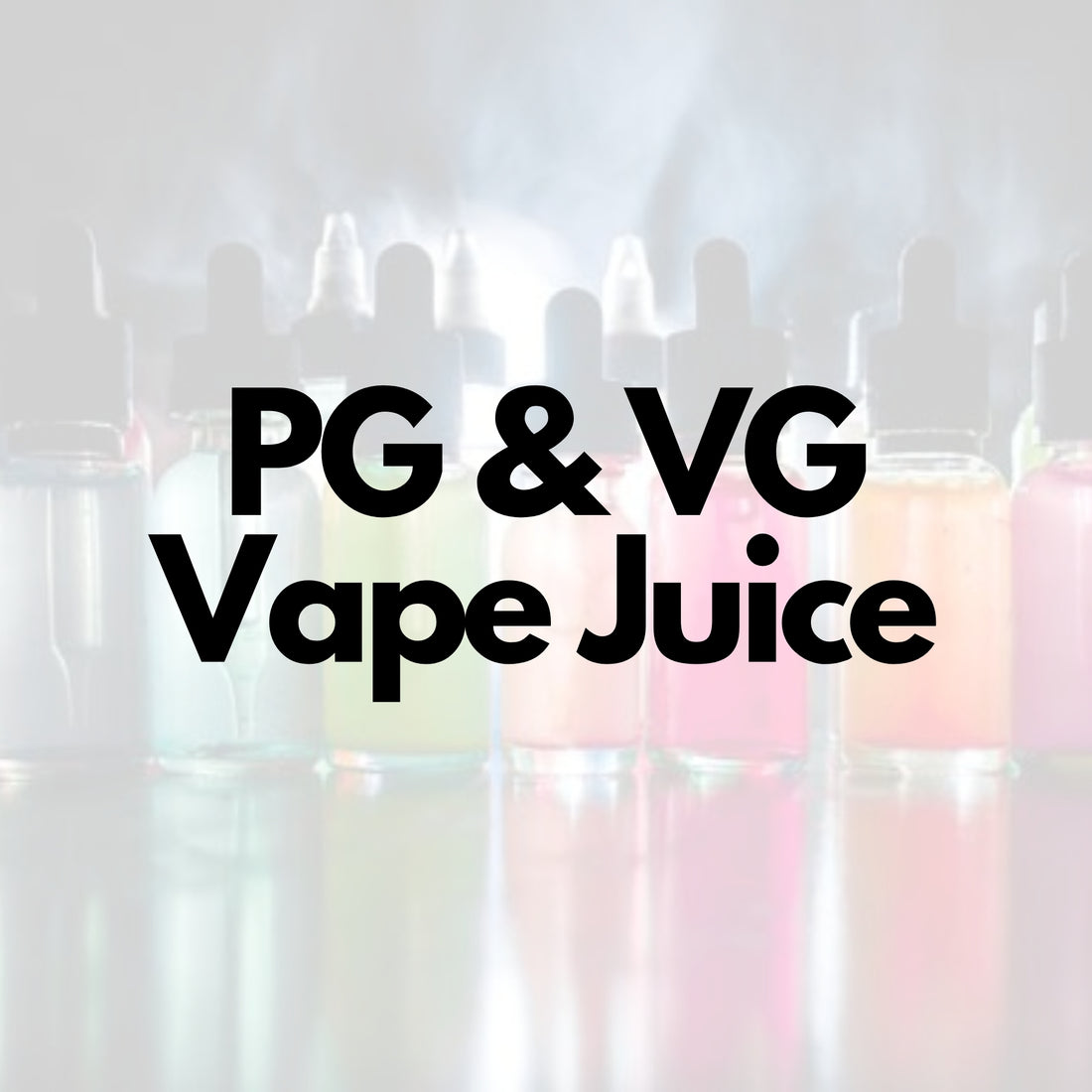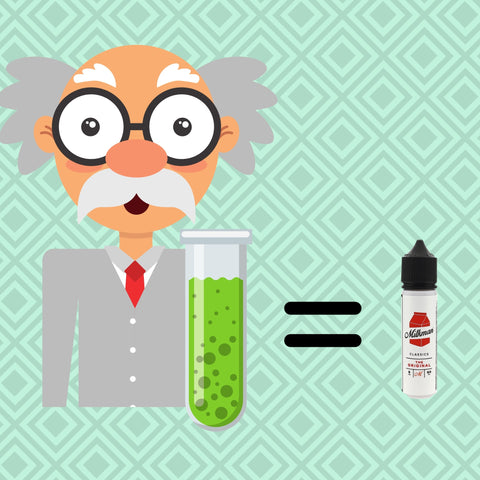
Share
Meaning of PG and VG in Vape Juice
Vape Juice and What Makes it
Vape Juice or e-liquid or e-juice refers to the fluid that makes vaping possible. It is the key element that creates the vapor when you use your vape pen. For vape juice to actually be capable of producing vapor, and thus make vaping possible, it has to be created with certain special ingredients. The four key ingredients that makes up a vape juice include Propylene Glycol (PG), Vegetable Glycerine (VG), flavoring and nicotine.
However, not all vape juices are produced with nicotine in them. There are vapers who prefer nicotine-free vape juice and as such manufacturers of vape juice have provided them with the option of vape juices that have absolutely no nicotine. But nicotine-free or not, almost every vape juice contains Propylene Glycol (PG) and Vegetable Glycerine (VG) in different ratios which have significant effects on the vape juice. This piece will help you understand the meaning of PG and VG in vape juice without any misconception.

What is Propylene Glycol (PG)?
Propylene Glycol (PG) is one of the food-safe liquids used in the production of vape juices. PG is a petroleum by-product that has a thin consistency and comes out odorless, colorless and tasteless. Propylene Glycol (PG) is not an oil, therefore it has none of the harmful effects that inhaling oils can cause. Propylene Glycol (PG) is the ingredient that is responsible for creating the throat hit that some vapers have described as being similar to the sensation of inhaling tobacco cigarettes. The thin consistency of Propylene Glycol (PG) makes it possible for the flavor of the vape juice to be more pronounced. Vape juice with high ratio of Propylene Glycol (PG) also increases the strength of the throat hit.
Propylene Glycol (PG) is usually not harmful to general health as it is a certified food-safe and non-toxic liquid. As a matter of fact, PGs are used in other widely popular consumer products like tooth pastes, beauty products including shampoos, baby wipes, make-up and even in some pet food.

What is Vegetable Glycerine (VG)?
Vegetable Glycerine (VG) like Propylene Glycol (PG) is another food-safe liquid that is equally used in the production of vape juices. Unlike Propylene Glycol (PG), however, it is not a petroleum by-product but a natural substance from vegetable oils. As such, vegetarians would be completely fine with using it. Vegetable Glycerine (VG) has a sweet taste that mildly alters the original taste of a vape juice and makes it sweeter.
VGs also have a milder throat hit compared to PG which makes it smoother to inhale. Vegetable Glycerine (VG) has a viscous consistency that results in a thick cloud production on exhalation. However, the viscosity of VGs also make it a prime cause of build ups that could clog your device. As such, your device might need more cleaning.
Similar to Propylene Glycol (PG), Vegetable Glycerine (VG) is also used in other consumer products. Some of the other popular uses of Vegetable Glycerine (VG) include in pet food, soaps, tooth paste, hand creams, and beauty products like aftershaves, deodorants, bubble baths, etc.
Understand that while both Propylene Glycol (PG) and Vegetable Glycerine (VG) are food-safe liquids and equally essential to the production of vape juice, they have different functions. You see, Propylene Glycol (PG) is largely responsible for the hits that come from vaping. Its tasteless nature also makes it the perfect conduit for transferring the flavor contained in the vape juice.
The fact that Propylene Glycol (PG) has a thin consistency makes it easier for the vape juice to quickly and consistently saturate the wick of your device and prevent burnouts. On the other hand, Vegetable Glycerine (VG) is responsible for creating thick and denser clouds when you vape. It also acts as the key sweetener in vape juices. The fact that Vegetable Glycerine (VG) has a viscous consistency reduces the likelihood of oversaturation of the coil which can help to prevent vape spitbacks.

PG/VG Ratios in Vape Juices
Now that you have a fundamental understanding of the meaning of Propylene Glycol (PG) and Vegetable Glycerine (VG) in vape juices, as well as their key functions, you need to realize the likely impact of the quantity of each used on vape juices and the overall vaping experience. The PG/VG ratio refers to the quantity of Propylene Glycol (PG) and Vegetable Glycerine (VG) relative to each other used in the production of vape juices. The PG/VG ratio can potentially alter the outcome of a vape juice. As such, it is important for you to understand the different types of vape juices based on the PG/VG ratio and subsequently determine which one is best for you. Below are the most common types of PG/VG ratio used in vape juices:
70/30 PG/VG Ratio
Vape juices produced with more Propylene Glycol (PG) than Vegetable Glycerine (VG) often use this ratio or one with even higher quantity of PG. They have a thinner consistency compared to other types of vape juices. Vape juices produced with this PG/VG ratio also pack a stronger throat hit but have lower cloud production. Devices with low wattage are ideal for vaping this kind of vape juice.
50/50 PG/VG Ratio
Vape juices produced with a 50/50 PG/VG ratio contains an equal amount of Propylene Glycol (PG) and Vegetable Glycerine (VG) that creates a delicate balance between cloud production and flavor delivery. This ratio also guarantees a balanced throat hit. Vape juices manufactured using this ratio are extremely versatile as they can be used on both sub ohm and plus ohm vaping devices.

Max VG Ratio
Max VG ratio refers to the ratio adopted when the quantity of Vegetable Glycerine (VG) used in a vape juice is greater than the quantity of Propylene Glycol (PG) used. Vape juices using this ratio have a largely viscous consistency that makes it ideal for sub ohm vaping on devices with high wattage. The high VG content encourages thicker cloud production and lower throat hits. Vape juices produced with this ratio also tend to have a milder flavor as the high Vegetable Glycerine (VG) content dilutes the added flavor.
Now that you know the meaning of PG, VG and how their ratio can significantly affect the outcome of your vaping experience, you now have the ability to choose the liquid that will guarantee the most enjoyable vaping experience for you.
Related Blog Posts
CBD OIL AND VAPE JUICE DIFFERENCES
